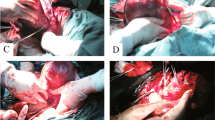Abstract
Objective
To observe the efficacy and safety of a uterine folding hemostatic technique in controlling atonic postpartum hemorrhage (PPH) during cesarean delivery.
Methods
Thirty-nine women with severe postpartum bleeding from uterine inertia, which did not react to conventional initial management protocols, underwent a uterine folding hemostasis. The procedure was to fold the uterine fundus onto the anterior wall of the corpus uterus using an absorbable suture that thread tautly through the inner myometrial layer of the uterus 1–3 cm below the fundus (not entered into uterine cavity) and 1–2 cm above and below the CS incision (entered into uterine cavity 2–4 cm medal to bilateral border of the uterus).
Results
The technique was sufficient to stanch bleeding immediately in 32 patients (82.1 %). Seven women underwent hypogastric arteries ligation (1 case) or uterine arterial embolization (6 cases) because of continuous bleeding after the procedure. There were no morbidities or abnormalities of the uterus in these 32 patients. Eight women had pregnancies after this hemostasis and the others lacked the desire for future pregnancy.
Conclusion
Uterine folding hemostasis is a simple, safe and effective technique to control the atonic PPH.



Similar content being viewed by others
References
El Ayadi AM, Robinson N, Geller S, Miller S (2013) Advances in the treatment of postpartum hemorrhage. Expert Rev Obstet Gynecol 8(6):525–537
Hancock A, Weeks AD, Lavender DT (2015) Is accurate and reliable blood loss estimation the ‘crucial step’ in early detection of postpartum haemorrhage: an integrative review of the literature. BMC Pregnancy Childbirth 28(15):230. doi:10.1186/s12884-015-0653-6
Say L, Chou D, Gemmill A, Tunçalp Ö, Moller AB, Daniels J et al (2014) Global causes of maternal death: a WHO systematic analysis. Lancet Glob Health 2(6):e323–e333
Ronsmans C, Graham WJ (2006) Maternal mortality: who, when, where, and why. Lancet 368(9542):1189–1200
Khan KS, Wojdyla D, Say L, Gülmezoglu AM, Van Look PFA (2006) WHO analysis of causes of maternal death: a systematic review. Lancet 367(9516):1066–1074
World Health Organization (2012) WHO recommendations for the prevention and treatment of postpartum haemorrhage. World Health Organization, Geneva. Available from: http://www.ncbi.nlm.nih.gov/books/NBK131942/
Weisbrod AB, Sheppard FR, Chernofsky MR, Blankenship CL, Gage F, Wind G et al (2009) Emergent management of postpartum hemorrhage for the general and acute care surgeon. World J Emerg Surg 25(4):43. doi:10.1186/1749-7922-4-43
Mallappa Saroja CS, Nankani A, El-Hamamy E (2010) Uterine compression sutures, an update: review of efficacy, safety and complications of B-Lynch suture and other uterine compression techniques for postpartum haemorrhage. Arch Gynecol Obstet 281(4):581–588
Li GT, Li XF, Li J, Liu YJ, Xu HM (2015) Reflexed compression suture for the management of atonic postpartum hemorrhage with an abnormally adherent placenta. Gynecol Obstet Invest 80(4):228–233
Dedes I, Ziogas V (2008) Circular isthmic-cervical sutures can be an alternative method to control peripartum haemorrhage during caesarean section for placenta praevia accreta. Arch Gynecol Obstet 278(6):555–557
Ajenifuja KO, Adepiti CA, Ogunniyi SO (2010) Postpartum haemorrhage in a teaching hospital in Nigeria: a 5-year experience. Afr Health Sci 10(1):71–74
Shabana A, Fawzy M, Refaie W (2015) Conservative management of placenta percreta: a stepwise approach. Arch Gynecol Obstet 291(5):993–998
Blanc J, Courbiere B, Desbriere R, Bretelle F, Boubli L, D’Ercole C, Carcopino X (2012) Uterine-sparing surgical management of postpartum hemorrhage: is it always effective? Arch Gynecol Obstet 285(4):925–930
Rath W, Hackethal A, Bohlmann MK (2012) Second-line treatment of postpartum haemorrhage (PPH). Arch Gynecol Obstet 286(3):549–561
Matsubara S, Yano H, Ohkuchi A, Kuwata T, Usui R, Suzuki M (2013) Uterine compression sutures for postpartum hemorrhage: an overview. Acta Obstet Gynecol Scand 92(4):378–385
Saxena R (2011) Tips and tricks in operative obstetrics and gynecology, 2nd edn. Jaypee Brothers Medical Pub, New Delhi, pp 243–246. ISBN 978-9350252383
El-Hamamy E, B-Lynch C (2005) A worldwide review of the uses of the uterine compression suture techniques as alternative to hysterectomy in the management of severe post-partum haemorrhage. J Obstet Gynaecol 25(2):143–149
Li GT, Li XF, Wu BP, Li GR, Xu HM (2015) Three cornerstones of uterine compression sutures: simplicity, safety and efficacy. Arch Gynecol Obstet 292(5):949–952
Simpson AN, Pittini R, Hui D, Morgan A, Kroft J (2015) Uterine full thickness multifocal dehiscence associated with a history of Cho uterine compression sutures. J Obstet Gynaecol Can 37(7):583–584
B-Lynch C, Coker A, Lawal AH, Abu J, Cowen MJ (1997) The B-Lynch surgical technique for the control of massive postpartum haemorrhage: an alternative to hysterectomy? Five cases reported. BJOG 104(3):372–375
American College of Obstetricians and Gynecologists (2006) ACOG practice bulletin: clinical management guidelines for obstetrician-gynecologists number 76: postpartum hemorrhage. Obstet Gynecol 108(4):1039–1047
El-Hamamy E, Wright A, B-Lynch C (2009) The B-Lynch suture technique for postpartum haemorrhage: a decade of experience and outcome. J Obstet Gynaecol 29(4):278–283
Authors’ contributions
GT Li conceived the idea, designed and performed the surgical procedure, drafted the manuscript and figures. GR Li conceived the initial idea, developed the project and supervised the experiments. HM Xu, BP Wu and XN Wang collected and analyzed the data, wrote the manuscript, observed the complications and developed the illustrations and figures.
Funding source
No funding source was involved.
Author information
Authors and Affiliations
Corresponding author
Ethics declarations
The study protocol had been approved by The Local Ethical Committee of Meitan General Hospital.
Conflict of interests
The authors declare that they have no conflict of interest.
Disclosure statement
The authors declare that we have no financial and personal relationships with other people or organizations that can inappropriately influence their work; there is no professional or other personal interest of any nature or kind in any product, service and/or company that could be construed as influencing the position presented in, or the review of, the manuscript entitled.
Additional information
G.-T. Li and G.-R. Li contributed equally to this study and share first authorship.
Rights and permissions
About this article
Cite this article
Li, GT., Li, GR., Xu, HM. et al. Uterine folding hemostasis: a simpler and safer technique for controlling atonic postpartum hemorrhage. Arch Gynecol Obstet 294, 689–695 (2016). https://doi.org/10.1007/s00404-016-4009-x
Received:
Accepted:
Published:
Issue Date:
DOI: https://doi.org/10.1007/s00404-016-4009-x




